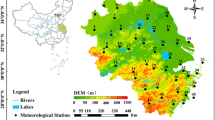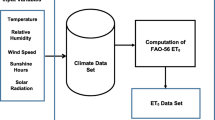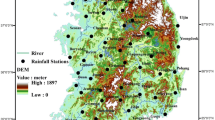Abstract
Reference crop evapotranspiration (ET0) is one of the most important climatic parameters which plays a key role in estimating crop water demand and scheduling irrigation. Under global warming and climate change conditions, it is needed to survey the trend of ET0 in Iran. In this study, ET0 values were determined based on FAO-56 Penman-Monteith equation over 32 synoptic meteorological stations during 1960–2005; and analyzed spatially and temporally in monthly, seasonal and annual time scales. After removing the significant lag-1 serial correlation effect by pre-whitening, non-parametric statistical Mann–Kendall (MK) test was used to detect the trends. The slope of the changes was determined by Sen’s slope estimator. In order to facilitate in trend analysis, the 10 moving average low pass filter were also applied on the normalized annual ET0 time series. Annual ET0 time series and filtered ones were then classified by hierarchical clustering in three clusters and then mapped in order to show the patterns of different clusters. Results showed that the significant decreasing trends were more considerable than increasing ones. Among surveyed stations, and on an annual time scale, the highest and lowest annual values of Sen’s slope estimator were observed in Tabas with (+) 72.14 mm per decade and Shahrud with (−) 62.22 mm per decade, respectively. Results also indicated that the clustered map based on normalized and filtered annual ET0 time series is in accordance with another map which showed spatial distribution of increasing, decreasing and non-significant trends of ET0 on annually time scale. Exploratory and visual analysis of smoothed time series showed increasing trend in recent years especially after 1980 and 1995. In brief, the upward trend of ET0 in recent years is a crucial issue with regard to the high cost of dam construction for agricultural aims in arid and semi-arid regions e.g. Iran.











Similar content being viewed by others
References
Ahani H, Kherad M, Kousari MR, Roosmalen Lv, Aryanfar R, Hosseini SM (2012) Non-parametric trend analysis of the aridity index for three large arid and semi-arid basins in Iran. Theor Appl Climatol. In press
Ahrens CD (1998) Essentials of meteorology, an introduction to the atmosphere, 2nd edn. Publishing Company, Wadsworth
Alexandris S, Kerkides P, Liakatas A (2006) Daily reference evapotranspiration estimates by the “Copais” approach. Agric Water Manage 82:371–386
Alizadeh A, Keshavarz A (2005) Status of agricultural water use in Iran. In: Water conservation, reuse, and recycling: proceedings of an Iranian-American workshop. The National Academies Press, Washington, DC, pp 94–105
Allen RG (2000) Using the FAO-56 dual crop coefficient method over an irrigated region as part of an evapotranspiration intercomparison study. J Hydrol 229:27–41
Allen RG, Pereira LS, Raes D, Smith M (1998) Crop evapotranspiration. FAO Irrigation and Drainage Paper 56, Food and Agriculture Organization, Rome
Amatya DM, Skaggs RW, Gregory JD (1995) Comparison of methods for estimating REF-ET. J Irrig Drain Eng 121:427–435
Asadi Zarch MA, Mobin MH, Malekinezhad H, Dastorani MT, Kousari MR (2011) Drought monitoring by Reconnaissance Drought Index (RDI) in Iran. Water Resour Manage 25:3485–3504
Chattopadhyay N, Hulme M (1997) Evaporation and potential evapotranspiration in India under conditions of recent and future climate change. Agr Forest Meteorol 87:55–73
Chen SB, Liu YF, Thomas A (2006) Climatic change on the Tibetan plateau: potential evapotranspiration trends from 1961 to 2000. Clim Chang 76:291–319
Dinpashoh Y, Jhajharia D, Fakheri-Fard A, Singh VP, Kahya E (2011) Trends in reference crop evapotranspiration over Iran. J Hydrol 399:422–433
Douglas EM, Jacobs JM, Sumner DM, Ray RL (2009) A comparison of models for estimating potential evapotranspiration for Florida land cover types. J Hydrol 373:366–376
Duhan D, Pandey A (2012) Statistical analysis of long term spatial and temporal trends of precipitation during 1901–2002 at Madhya Pradesh, India. Atmos Res. In Press
Earle D (2010) Dendrogram seriation in data visualisation: algorithms and applications, PhD thesis National University of Ireland Maynooth, Department of Mathematics
Espadafor M, Lorite IJ, Gavilán P, Berengena J (2011) An analysis of the tendency of reference evapotranspiration estimates and other climate variables during the last 45 years in Southern Spain. Agric Water Manage 98:1045–1061
Fan Z, Thomas A (2013) Spatiotemporal variability of reference evapotranspiration and its contributing climatic factors in Yunnan Province, SW China, 1961–2004. Clim Change 116:309–325
Farmer CJQ, Nelson TA, Wulder MA, Derksen C (2010) Identification of snow cover regimes through spatial and temporal clustering of satellite microwave brightness temperatures. Remote Sens Environ 114(1):199–210
Farris JS (1969) On the cophenetic correlation coefficient. Systematic Zoology (Syst Biol) 18:279–285
Fisher JB, DeBiase TA, Qi Y, Xu M, Goldstein AH (2005) Evapotranspiration models compared on a Sierra Nevada forest ecosystem. Environ Model Softw 20:783–796
Florides GA, Christodoulides P (2009) Global warming and carbon dioxide through sciences. Environ Int 35:390–401
Ghazi I (2002) Water resources management and planning in Iran. Report to the University of Isfahan, Iran (in Persian)
Gong X, Richman MB (1995) On the application of cluster analysis to growing season precipitation data in North America east of the Rockies. J Clim 8:897–931
Hirsch R, Helsel D, Cohn T, Ilroy E (1993) Statistical analysis of hydrologic data, handbook of hydrology. McGraw-Hill, New York
Hunsaker DJ, Pinter PJ, Cai H (2002) Alfalfa basal crop coefficients for FAO-56 procedures in the desert regions of the southwestern US. Trans ASAE 45:1799–1815
Johnston JW (1976) Similarity indices I: What do they measure, Battelle Pacific Northwest Labs, Richland, WA, USA
Kaufman L, Rousseeuw PJ (1990) Finding groups in data. Wiley, New York
Kendall MG (1975) Rank correlation methods. Griffin, London
Kiely G (1999) Climate change in Ireland from precipitation and stream flow. Adv Water Resour 23:141–151
Kousari MR, Asadi Zarch MA (2010) Minimum, maximum, and mean annual temperatures, relative humidity, and precipitation trends in arid and semi-arid regions of Iran. Arab J Geosci 4:907–914
Kousari MR, Ahani H (2012) An investigation on reference crop evapotranspiration trend from 1975 to 2005 in Iran. Int J Climatol 32:2387–2402
Lim WH, Roderick ML, Hobbins MT, Wong SC, Groeneveld PJ, Sun F, Farquhar GD (2012) The aerodynamics of pan evaporation. Agric For Meteorol 152:31–43
Lin GF, Wu MC (2007) A SOM-based approach to estimating design hyetographs of ungauged sites. J Hydrol 339:216–226
Mann HB (1945) Non-parametric tests against trend. Econometrica 13:245–259
MathWorks (2001) Statistics Toolbox: For Use with Matlab: User’s Guide. MathWorks
Mckenna JE (2003) An enhanced cluster analysis program with bootstrap significance testing for ecological community analysis. Environ Model Softw 18:205–220
McVicar TR, Roderick ML, Donohue RJ, Van Niel TG (2012) Less bluster ahead? Ecohydrological implications of global trends of terrestrial near-surface wind speeds. Ecohydrology 5:381–388
Nathan RJ, McMahon TA (1990) Identification of homogeneous regions for the purposes of regionalization. J Hydrol 121:217–238
Nemec AFL, Brinkhurst RO (1988) Using the bootstrap to assess statistical significance in the cluster analysis of species abundance data. Can J Fish Aquat Sci 45:965–970
Oki T, Kanae S (2006) Global hydrological cycles and world water resources. Science 313:1068–1072
Peterson T, Golubev V, Groisman P (1995) Evaporation losing its strength. Nature 377:687–688
Poff N (1996) A hydrogeography of unregulated streams in the United States and an examination of scale-dependence in some hydrological descriptors. Freshwater Biol 36:71–79
Rao AR, Srinivas VV (2006) Regionalization of watersheds by hybrid-cluster analysis. J Hydrol 318:37–56
Roderick ML, Farquhar GD (2002) The cause of decreased pan evaporation over the past 50 years. Science 298:1410–1411
Roderick ML, Farquhar GD (2004) Changes in Australian pan evaporation from 1970 to 2002. Int J Climatol 24:1077–1090
Sahin S, Cigizoglu HK (2012) The sub-climate regions and the sub-precipitation regime regions in Turkey. J Hydrol 450–451:180–189
Sen PK (1968) Estimates of the regression coefficient based on Kendall’s tau. J Am Stat Assoc 63:1379–1389
Sneath PHA, Sokal RR (1973) Numerical taxonomy: the principles and practice of numerical classification. WH Freeman & Co, San Francisco
Sneyers R (1990) On the statistical analysis of series of observations. WMO Technical Note 143,World Meteorological Organization, Geneva, pp 192
Spano D, Snyder RL, Sirca C, Duce P (2009) ECOWAT—a model for ecosystem evapotranspiration estimation. Agric For Meteorol 149:1584–1596
Tabari H, Aghajanloo MB (2012) Temporal pattern of aridity index in Iran with considering precipitation and evapotranspiration trends. Int J Climatol. In press
Tabari H, Hosseinzadeh Talaee P (2011) Recent trends of mean, maximum and minimum air temperatures in the western half of Iran. Meteorol Atmos Phys 111:121–131
Tabari H, Nikbakht J, Hosseinzadeh Talaee P (2012) Identification of Trend in Reference Evapotranspiration Series with Serial Dependence in Iran. Water Resour Manage. In press
Unal Y, Kindap T, Karaca M et al (2003) Redefining the climate zones of Turkey using cluster analysis. Int J Climatol 23:1045–1055
Wu SH, Yin YH, Zheng D, Yang QY (2006) Moisture conditions and climate trends in China during the period 1971–2000. Int J Climatol 26:193–206
Xu CY, Singh VP (2005) Evaluation of three complementary relationship evapotranspiration models by water balance approach to estimate actual regional evapotranspiration in different climatic regions. J Hydrol 308:105–121
Yin Y, Wu S, Zheng D, Yang Q (2008) Radiation calibration of FAO56 Penman–Monteith model to estimate reference crop evapotranspiration in China. Agric Water Manage 5:77–84
Yu Y, Zou S, Whittemore D (1993) Non-parametric trend analysis of water quality data of rivers in Kansas. J Hydrol 150:61–80
Zhai L, Feng Q (2008) Spatial and temporal pattern of precipitation and drought in Gansu Province, Northwest China. Nat Hazards 49:1–24
Acknowledgements
The authors gratefully appreciate the Cadastre group (Management Center for Strategic Projects) in Fars Organization of Agricultural Jahad for their support and providing research facilities. Also, the authors are grateful for the excellent research facilities provided by UNSW. Furthermore, we appreciate comments and suggestions made by the Referees which enhanced the quality of current work.
Author information
Authors and Affiliations
Corresponding author
Rights and permissions
About this article
Cite this article
Kousari, M.R., Asadi Zarch, M.A., Ahani, H. et al. A survey of temporal and spatial reference crop evapotranspiration trends in Iran from 1960 to 2005. Climatic Change 120, 277–298 (2013). https://doi.org/10.1007/s10584-013-0821-5
Received:
Accepted:
Published:
Issue Date:
DOI: https://doi.org/10.1007/s10584-013-0821-5




